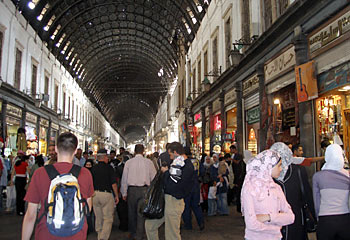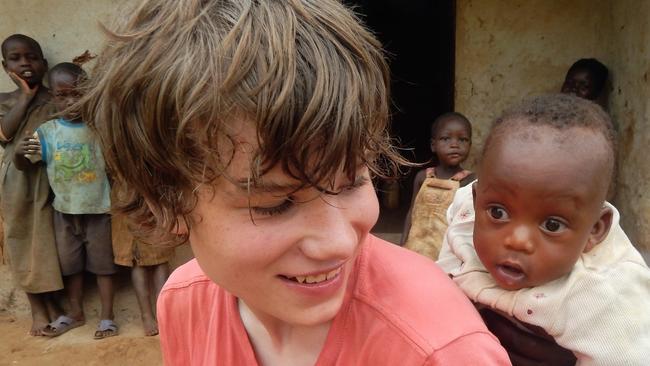On the road to Damascus
IT may seem absurd to suggest Syria as a tourist destination in these troubled times, but Alison Cotes now counts it as one of her favourite holiday spots.

IT may seem absurd to suggest Syria as a tourist destination in these troubled times, but I now count it as one of my favourite holiday spots.
Middle East violence has scared most visitors away, to the extent that tourist numbers have fallen 80 per cent this year. (The Australian Government advises travellers to reconsider their need to go to Syria, and to exercise extreme caution while there.)
But because the hordes of package holiday crowds have disappeared, you can wander around the ruins and through the bazaars without being jostled.
Personal safety is the big concern of most travellers, but I spent two weeks there with a group of three other Australians and a guide and we walked everywhere with no fear.
Even though (because of the large number of Saudis who live there) about 50 per cent of women wear hijab with a full face veil, my short, uncovered, spiky white hair roused no hostility.
Shopkeepers and other locals I spoke to were unfailingly courteous and helpful.
One day, exhausted after walking along the Street called Straight in the Old City of Damascus (readers who know their Bible will pick up the reference), I leaned against a shop door and the owner immediately came out with a chair and a cup of tea, even though I told him I had no money.
He made no attempt to take me into his shop and point out the excellence of his goods, but smiled genially as I sipped my tea and rested my weary feet.
In Syria, it's possible to walk through the souks (covered markets) and look at the goods in peace.
And it's cheap – exquisite silk scarves for about $5, sweets straight out of The Arabian Nights, and hand-made leather shoes for $8.
The latter I picked up in the tiny village of Palmyra, northeast of Damascus, where I had stopped to buy a new leather purse.
Walking along the street at 9pm in search of an internet cafe, I stopped at a hole-in-the-wall family business where the patriarch, his two sons and three grandsons sat cutting out leather shapes and fashioning them into elaborate slippers and sandals.
I sat down for the inevitable cup of tea and got into conversation (two of them spoke minimal English).
After half an hour I was wearing a pair of elegant house shoes with black and tan woven fronts, fashioned from camel skin as I watched, and had received an offer of marriage from the patriarch, which I declined politely, for he was seeking his third wife.
(I had two other proposals like this along the way, but caused no offence in refusing them all on the grounds that I'd be far too expensive to keep.)
The ruins at Palmyra are every bit as striking as the more famous site at Petra in neighbouring Jordan, and easier to get around on foot.
Palmyra was a Greco-Roman city of the 1st and 2nd centuries. Today it is a huge site of imposing columns and public arenas, with a near-perfect Roman theatre where we were entertained by an Arab pipe band – for a small fee, of course.
The castle Krak des Chevaliers was described by Lawrence of Arabia as the finest castle in the world. It was built by Arabs in 1031, then taken by the Crusaders and remodelled in the 12th century.
It's worth a whole day wandering through the impressive site, with long-drop dunnies still in place (but no longer useable) and a small chapel from which fiery pilgrim priests preached damnation to all Muslims.
Here, you can see why Saladin is the hero and the Christian Crusaders the villains. Saladin's tomb in Damascus is still venerated by Muslims.
In Aleppo we stayed in an early 17th century merchant's house, its glorious inlaid marble rooms now converted to a charming boutique hotel.
Aleppo's souk extends for almost 17km, so it's easy to get lost, but that's not a worry in such an Aladdin's cave.
Souvenir-hunters over the past 1500 years have reduced the 15m-high stone pillar sat on by St Simeon for 37 years to about 2m, which can been seen at St Simeon Monastery.
And so to Ugarit, in one sense just another bloody ruin. It's important not for its beauty, but because here was found a clay tablet, now in the Damascus National Museum, on which is inscribed the very first alphabet (as opposed to pictogram) discovered in the world.
Which leads us immediately to Damascus, with its mighty museum and its imposing Umayyad Mosque – the fourth most-holy place in the Islamic world, open to all visitors as long as they are decently dressed.
And thence to the magnificent souk, full of strange silks and gold jewellery, its ancient roof letting in the rain, where sheep carcasses stand side-by-side with shops selling candied almonds and rose-petal jam, and a man making wooden sandals rests from his labours to study the Koran.
In this part of the Old City, Christians and Muslims live peacefully together, and the ancient Roman arch that separates the Muslim from the Christian part of the city is no barrier to anyone.
I can't think of a single reason not to go to Syria.
There is no terrorism, street crime is almost non-existent, and there's no public drunkenness or harassment of women.
And there are benefits for tourists at the moment, too – low visitor numbers means easier access to the best sites, no crowds, lower prices and a genuine welcome.
Certainly I wouldn't want to live there. But it's a great place to visit, so don't strike it off your list.
Sunday Mail (QLD)



